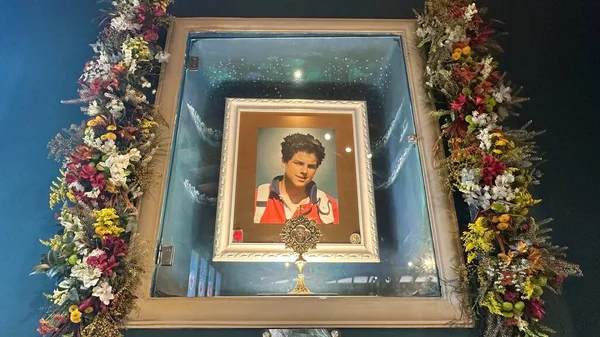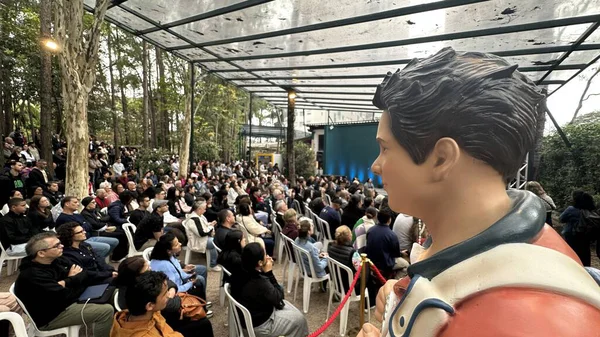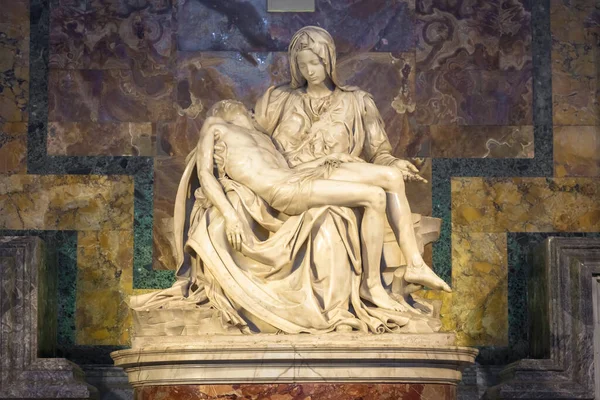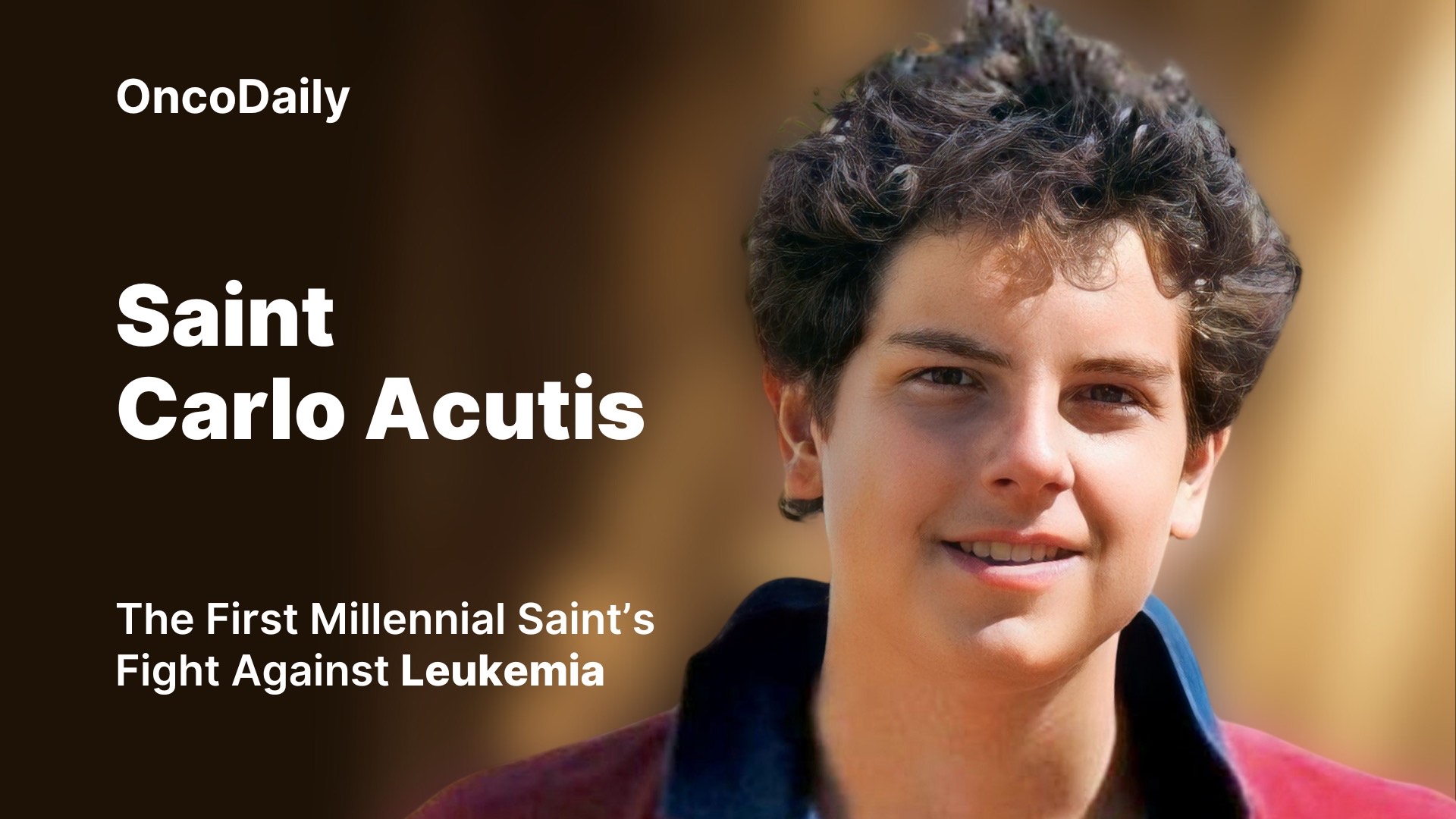“Happiness consists in being aware of our misery, and at the same time, of being loved by God.”
Saint Carlo Acutis was a remarkable young Catholic known for his deep faith and his extraordinary ability to use modern technology to share his beliefs. Born in London in 1991 and raised mostly in Milan, Italy, Carlo was passionate about computers from a young age, teaching himself programming and web design. He created a groundbreaking website to catalog Eucharistic miracles around the world, earning him the nickname “the patron saint of the Internet.”

Photo:Depositphotos
Despite his tech-savvy nature, Carlo’s spirituality was profound. He had a deep love for the Eucharist and made daily Mass and prayer central to his life from an early age. Saint Carlo Acutis: Faith, Courage, and Cancer Journey of the First Millennial Saint
Carlo’s life was tragically cut short at just 15 years old when he was diagnosed with leukemia. Throughout his illness, he displayed immense courage and unwavering faith, accepting suffering as part of his journey. His cancer battle became a powerful testimony to his determination to live holy and joyful despite adversity.
Carlo Acutis’s story holds significant meaning for people facing illness and challenges of faith in the modern world. He exemplifies how technology and faith can coexist, inspiring believers to embrace holiness with contemporary tools. His recent canonization highlights his enduring legacy as a symbol of hope, courage, and the transformative power of faith in the face of suffering.
Childhood and Upbringing of Carlo Acutis in London and Milan
Carlo Acutis was born on May 3, 1991, in London to Italian parents Andrea Acutis and Antonia Salzano, who were not particularly religious. Shortly after his birth, the family moved to Milan, Italy, where Carlo was raised. From a young age, Carlo displayed a remarkable devotion to God, despite his parents’ initial lack of strong religious practice. His deep faith was evident early on, as he frequently attended Mass and made daily prayer, especially devotion to the Eucharist, a central part of his life.
Carlo’s interest in spirituality was matched by his passion for technology. He was a gifted computer programmer and used his skills to create a website cataloguing Eucharistic miracles worldwide, merging modern tools with his profound religious beliefs. This innovative approach earned him the title of “patron saint of the Internet,” inspiring many young people to embrace their faith through contemporary means.
Diagnosis of Leukemia and Spiritual Response of Carlo Acutis
Carlo Acutis, born in May 1991, was diagnosed with acute leukemia in October 2006 at the age of 15. Initially, his symptoms were mistaken for the flu, but as his condition worsened, he was hospitalized in Milan, Italy. Medical evaluations revealed the severe diagnosis of acute myeloid leukemia, a rapidly progressing form of cancer affecting the blood and bone marrow.
The news was undoubtedly distressing for Carlo, his family, and those close to him. Yet, from the very beginning, Carlo demonstrated a remarkable acceptance and courage. Instead of succumbing to despair, he chose to offer his suffering as a gift for the intentions of Pope Benedict XVI and for the entire Catholic Church. This deeply spiritual perspective was a source of comfort to him and inspired those around him.
Throughout his illness, Carlo remained devoted to his faith. His strong relationship with the Eucharist and constant prayer life sustained him during treatment and adversity. He faced pain, hospital stays, and eventual loss of physical strength with humility, often expressing a desire to use his suffering for a greater purpose—that of salvation and spiritual growth.
Carlo’s approach to his illness embodied a Christian understanding of redemptive suffering: accepting hardship with love and trust in God can bring spiritual benefits not only to oneself but also to others. His courage made him a role model for patients and believers facing similar trials and highlighted the integration of faith in confronting serious health challenges.

Sao Paulo (SP) 09/07/2025 – Canonization Mass of the young Carlo Acutis, The faithful and authorities filled the parish to celebrate. Photo: Depositphotos
Carlo Acutis’ Cancer Battle: Faith, Courage, and Support
When Carlo Acutis was diagnosed with acute promyelocytic leukemia in October 2006, his world and that of his family changed dramatically. Initially experiencing symptoms similar to a common illness, the rapid progression of his condition landed him in hospital intensive care in Milan, where doctors gave him limited chances of recovery. Despite the severity of his situation, Carlo’s faith remained unwavering.
Throughout his treatment, Carlo faced suffering with exceptional courage and hope. Rather than expressing fear or despair, he consistently maintained a joyful and calm demeanor. He once reassured his caregivers with the words,
“There are people who suffer much more than me,”
demonstrating remarkable empathy and acceptance of his fate. Carlo chose to offer his pain and suffering as a spiritual gift for the intentions of Pope Benedict XVI and the Catholic Church, embodying a powerful example of redemptive suffering.
Carlo’s family played a crucial role in supporting him emotionally and spiritually during this difficult time. His mother, Antonia Salzano, often spoke of his patience and faith, noting his deep love for the Eucharist and the way this devotion gave him strength. The church community provided additional spiritual support, with hospital chaplains administering the sacraments of Anointing of the Sick and Holy Communion shortly before his passing.
The medical staff caring for Carlo also remembered him for his composure and spiritual maturity despite the excruciating pain caused by leukemia. His gentle demeanor and inner peace made a lasting impression, turning him into a beacon of hope and faith for patients, families, and healthcare workers alike.
Carlo passed away peacefully on October 12, 2006, but his courage and sanctity continue to inspire millions worldwide, showing how faith can triumph over suffering with grace and dignity.
How Did Carlo Acutis Become a Saint?
Carlo Acutis was beatified by the Catholic Church on October 10, 2020, in a ceremony held in Assisi, Italy, where his mortal remains rest. His beatification followed the recognition of a miracle attributed to his intercession—a healing of a Brazilian child born with a rare pancreatic defect. This paved the way for his canonization as a saint.
On September 7, 2025, Carlo Acutis was canonized by Pope Leo XIV at St. Peter’s Square in Vatican City. This ceremony marked a historic moment as Carlo became the first millennial saint officially recognized by the Catholic Church. His canonization was celebrated alongside Blessed Pier Giorgio Frassati, another young layman renowned for his faith and charity.
Carlo’s legacy extends far beyond his brief life. He is widely regarded as a role model for young Catholics, exemplifying how to live a holy life in the modern digital age. His creative use of technology to catalog Eucharistic miracles worldwide earned him the title of “Patron Saint of the Internet.” Through his website and online evangelism, Carlo demonstrated the power of faith combined with contemporary tools to inspire a new generation.
Young people and patients battling illness especially look to Carlo as a beacon of hope and courage. His joyful acceptance of suffering, deep spirituality, and ability to integrate faith with everyday life continue to encourage many to embrace holiness in a fast-changing world.
Carlo’s enduring impact is visible in the hundreds of thousands of pilgrims who visit his tomb in Assisi annually, seeking his intercession. His story resonates globally as a testimony to the transformative power of faith, technology, and courage.
Finding Light in the Darkness: Carlo Acutis’s Lesson in Courage
Saint Carlo Acutis’ story is a powerful testament to how faith can transform the experience of illness and suffering. Diagnosed with leukemia at just 15 years old, Carlo faced his sudden and severe illness with remarkable courage and spiritual maturity. Throughout his short but impactful life, he consistently demonstrated that suffering can have profound meaning when offered with love and trust in God.
Carlo taught that sadness comes from looking inward at ourselves, while true happiness is found by looking toward God. His unwavering faith in the presence of Christ in the Eucharist gave him strength to endure pain with joy and hope. Chronicling Eucharistic miracles around the world, he showed how the divine could manifest in everyday life, even in moments of trial.
For patients and families battling cancer or other serious diseases, Carlo’s life serves as an encouragement to find purpose and peace amid adversity. His example reveals that illness is not just a physical challenge but also a spiritual journey that can deepen one’s relationship with God. Offering one’s pain in union with Christ’s suffering can bring comfort, healing, and a sense of participation in a greater divine plan.
Carlo’s legacy encourages all who face hardship to embrace faith and courage, to seek holiness daily, and to trust in God’s love. His life reminds us that even in the darkest times, the light of God’s grace can transform suffering into a source of strength and hope.
Spiritual Teachings and Writings of Carlo Acutis
Saint Carlo Acutis left behind a small but profound legacy of spiritual reflections, prayers, and writings that reveal his deep wisdom and maturity despite his young age. His personal notes and emails often contained insights into his relationship with God and his longing for holiness.
One of his well-known reflections is:
“To always be close to Jesus, that’s my life plan.”
This simple yet powerful statement captures the essence of Carlo’s spiritual focus—living intimately connected with Christ in daily life.
The Eucharist as the “Highway to Heaven”
Carlo famously described the Eucharist as the “highway to heaven,” reflecting his profound belief in the Real Presence of Christ in the Eucharist and its centrality in spiritual life. For Carlo, the Eucharist was not just a ritual but a living encounter that nourished and transformed his soul.
He once said:
“The only way to paradise is through the Eucharist.”

The Pity, 1498-1499, located in St. Peter Basilica in Rome Photo: Depositphotos
This metaphor highlights the theological belief that the Eucharist is both a foretaste of heavenly glory and the means by which the faithful unite themselves to Christ’s sacrifice and resurrection. Receiving Communion sustains the spiritual journey, strengthens virtue, and fosters intimate union with Jesus.
Carlo’s dedication to attending daily Mass and receiving the Eucharist frequently demonstrated his conviction that the sacrament was essential for overcoming life’s challenges, including his illness. His website cataloging Eucharistic miracles around the world stemmed from this belief, aimed at inspiring others to trust in the Eucharistic presence as a source of grace and hope.
Through his writings and example, Carlo teaches that the Eucharist is the spiritual lifeline in a fast-paced, often distracted modern world—a divine path that leads believers toward eternal life.
You Can Also Read 10 Caring Notes from Pope Francis on Healthcare by OncoDaily

Written by Aharon Tsaturyan, MD, Lead of OncoDaily Volunteers, Editor at OncoDaily Intelligence Unit.
FAQ
Who was Carlo Acutis and why is he called the "patron saint of the Internet"?
Carlo Acutis was an English-born Italian teenager born in 1991, known for his deep faith and passion for computers. He taught himself programming and web design, creating a website that cataloged Eucharistic miracles worldwide. This innovative use of technology to share faith earned him the nickname "patron saint of the Internet." He was canonized in 2025 as the first millennial saint, symbolizing the harmony of faith and modern digital tools.
How did Carlo Acutis use technology to share his faith?
Carlo used his computer skills to build an extensive online catalog of Eucharistic miracles, making traditional Catholic devotion accessible through modern digital means. His website inspired many people globally and has been translated into several languages. He saw technology as a tool to evangelize and spread the message of the Eucharist, representing a new form of digital evangelism recognized by the Church.
What is the significance of Carlo Acutis’s website on Eucharistic miracles?
The website collects documented Eucharistic miracles from around the world, presenting them as evidence of the Real Presence of Christ in the Eucharist. This site aims to inspire faith, deepen devotion to the Eucharist, and connect believers digitally, bridging centuries-old Catholic traditions with contemporary communication methods.
How did Carlo Acutis demonstrate faith and courage during his leukemia illness?
Diagnosed with leukemia at 15, Carlo accepted his illness with remarkable courage and spiritual maturity. He offered his suffering as a gift for the Pope and the Catholic Church, maintaining a joyful and calm spirit amid pain and hospital stays. His deep Eucharistic devotion sustained him, making his cancer battle a testimony of redemptive suffering and hope.
What does it mean that Carlo Acutis described the Eucharist as the "highway to heaven"?
Carlo believed that the Eucharist was the essential spiritual path leading to eternal life. He saw Communion not just as a ritual but a living encounter with Christ that nourished and transformed the soul. This theological view underscores the Eucharist’s role in strengthening faith, virtue, and intimate union with Jesus as the foundation for Christian holiness.
What was the miracle that led to Carlo Acutis’s beatification and canonization?
Carlo’s beatification in 2020 followed the recognition of a miracle involving the healing of a Brazilian child born with a rare pancreatic defect after prayers invoking Carlo’s intercession. His canonization in 2025 included a second confirmed miracle: the recovery of a Costa Rican girl from a severe head injury.
How is Carlo Acutis considered a role model for young Catholics today?
Carlo’s blend of deep faith, joyful acceptance of suffering, and mastery of modern technology offers a relatable example for youth. He encourages young Catholics to live holy lives in the digital age, using their talents and tools to evangelize and embody Christian virtues. His story resonates with teens navigating faith in a fast-paced, tech-driven world.
How does the modern Church recognize saints like Carlo Acutis who lived in the digital age?
The Church embraces saints like Carlo as models for contemporary believers, officially recognizing his canonization after thorough investigation of his life and miracles. Carlo’s digital evangelism has been seen as a way to connect tradition with modern communication forms, helping the Church engage younger generations and affirming holiness within the context of technology.
When and where was Carlo Acutis canonized?
Carlo Acutis was canonized on September 7, 2025, by Pope Leo XIV in a ceremony held at St. Peter’s Square in Vatican City. This marked a historic moment as he became the first millennial saint officially recognized by the Catholic Church. The canonization ceremony was open to the public, with thousands of pilgrims attending to honor Carlo’s legacy alongside Blessed Pier Giorgio Frassati, another young layman known for his faith and charity.
What happened at Carlo Acutis’s canonization ceremony?
The canonization ceremony was presided over by Pope Leo XIV and included the formal declaration and veneration of Carlo Acutis as a saint of the Catholic Church. Attended by tens of thousands in St. Peter’s Square, the event celebrated Carlo’s extraordinary life of faith, his embrace of technology for evangelization, and his courageous battle with leukemia. The ceremony also highlighted his appeal as a role model for youth, symbolizing the Church’s connection with a new generation through saints living in the digital age.
